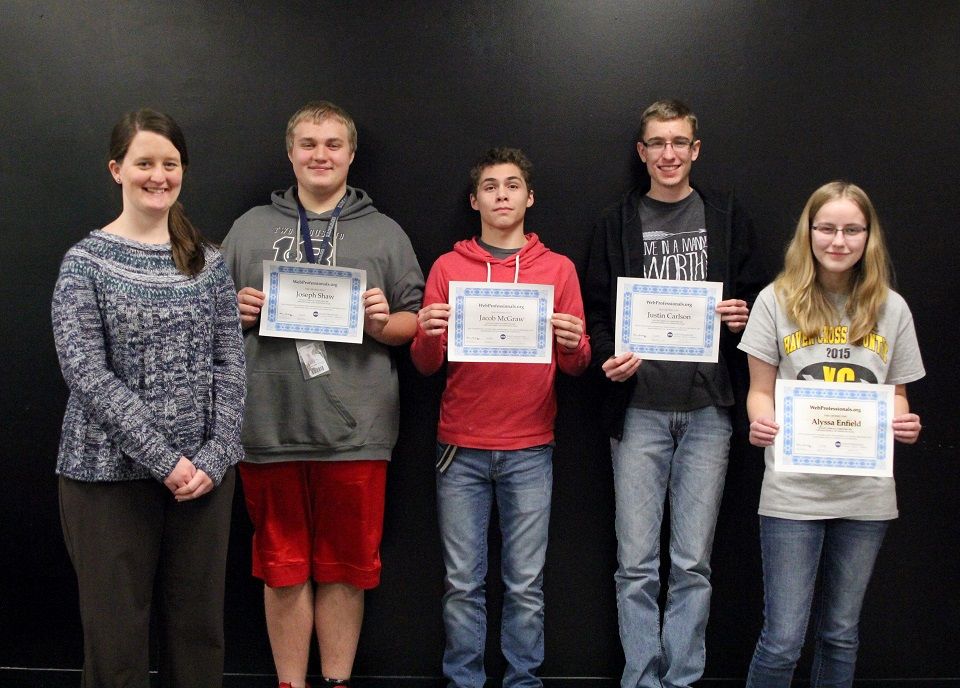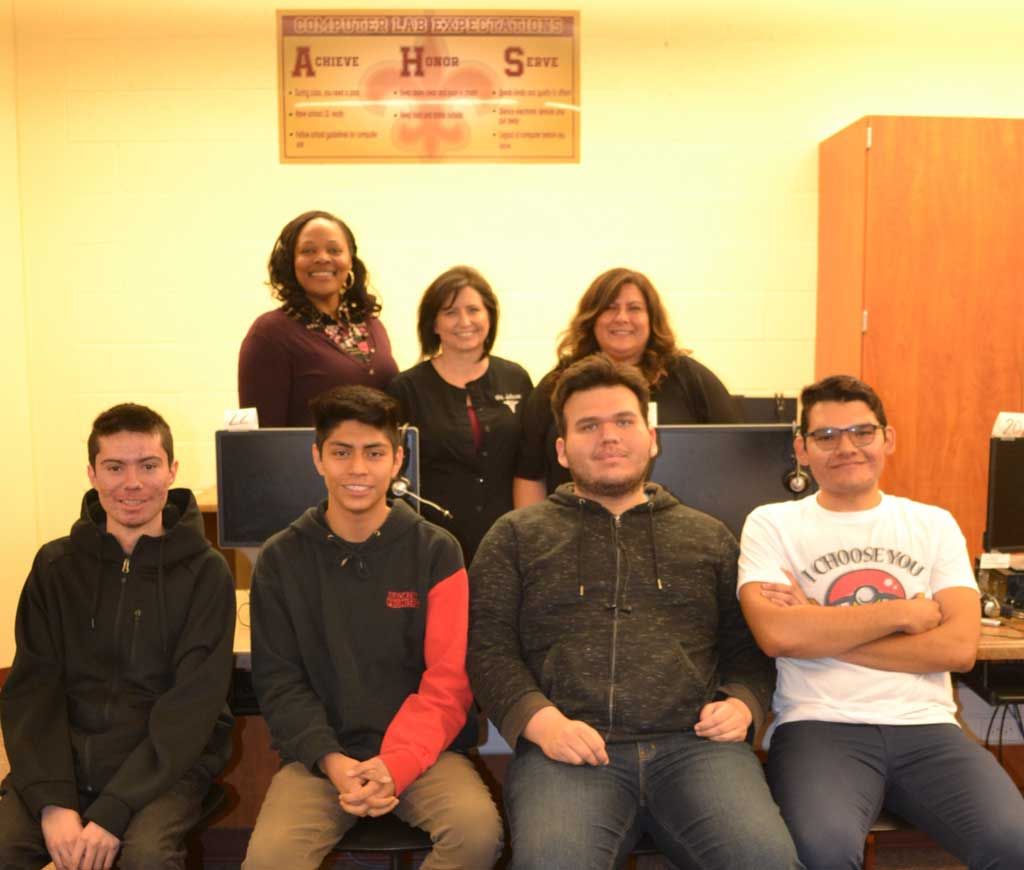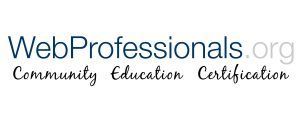Blog
California High School Students First in Nation to Earn New Web Animation Industry Recognized Certification
Congratulations – Adelanto High School
Adelanto, California May 16, 2019 – Four Adelanto High School Students are the first in the nation to earn the Web Animator International Industry Certification from the Web Professionals Association. As part of instructor Nikki Jarvis’ Design, Media and Visual Arts program , these students completed CTeLearning.com’s Web Animation Course and then passed the Web Professionals Web Animator Industry Certification Exam.
Top Row: Ebony Purcell , Monica LaBrosse, Nikki Jarvis
Bottom Row: Rodrigo Cortes-Rodrigues, Brandon Hernandez, Luis Rodriguez, and Zeus Toledo
Student’s Perspective
“I think the CTeLearning Web Animation course was simple, fun and easy to learn with. All the various projects helped build and practice my animation skills. One of the first projects I did was to create an animated commercial for a new handheld video game console. I came up with the commercial concept, wrote the script, created the characters, and animated the commercial just like a professional would do. The projects challenged my creativity, and it was on me to come up with the ideas to make a great animation. The course was very hands-on which is how I like to learn and it did a great job preparing me to pass the international industry exam. I am very proud to know that I have earned this certification while still in High School. Thank you to Ms. Jarvis and everybody here at AHS that helped to give me this opportunity. ”
Rodrigo Cortes – Animation Student and now Certified Web Animator
Graduating with Industry Recognized Certifications
“I am so proud of my students,” said AHS animation instructor Nikki Jarvis. “ When they graduate from AHS they will leave here with a real industry recognized certification
. This accomplishment will follow them for the rest of their lives. When they apply to college they can proudly list this certification. When they apply for a job, they will list this credential. This is just one more thing that makes them unique and helps them to stand out from the competition.” 
Ms. Jarvis is right. Today, more and more career savvy students recognize today the importance of earning industry recognized certifications . Parents are asking for schools to offer these opportunities, and forward-thinking educators like Ms. Jarvis are helping make it happen.
Students Becoming Professionals
It is very common for students to take the animation course solely for high school credit. However, those who want to gain the coveted industry recognized credential must receive a minimum course grade, meet all project performance requirements, exhibit professionalism in all class activities and receive a recommendation to sit for the exam by their course instructor. Ms. Jarvis’ students took the proctored exam at Adelanto High.
Mark DuBois, Executive Director of the Web Professionals Association, and his educational team were key in creating and maintaining the international industry certifications, which are optional for students in the course to pursue.
“We are very happy to welcome the Adelanto High students on their first step to becoming a professional in the world of web and web animation . The exciting world of web is so much more than just coding, and we are very proud to have these future web animators joining our ranks . I am not surprised that AHS is the first in the nation for this new credential. Adelanto has a great program and this is a testament to how the administration has supported their CTE department to help build an outstanding program. We look forward to meeting next year’s animators. All of us here at WebProfessionals.org love seeing students take these first important steps towards high-demand STEAM/STEM careers in web ,” said Mark DuBois.
Real Industry Recognized Certification – Not Just Another Test
Students and their parents are tired of all the tests students have to take. This exam is not delivered by a testing company, but it is a credentialing exam given by an industry professional association . There are many companies selling “industry exams,” but sadly these exams are seen by industry professionals as simply a test. Ms. Jarvis decided to offer a real, genuine industry-recognized certification opportunity to her students. It is a credential that actually comes from industry, and isn’t just from another testing company.
Students who achieved the credential gained membership to the Web Professionals Association . With this membership, the students have the opportunity to engage in the same learning opportunities and professionals’ access .
Animation’s History at Adelanto
Ms. Jarvis has been teaching Animation at Adelanto High School since the school opened in 2014, and this is the first year the Web Professionals Association has offered the web animator credentials. As soon as she heard this new credential would be available, she secured the opportunity to pilot this for her students. “ I wasn’t surprised when Ms. Jarvis asked us about how to implement the Web Animator industry certification for her students,” commented Steve Waddell, Founder of CTeLearning.com. “ Adelanto has always been one of those first adopter type schools , and Nikki attracts bright and talented students to her program. We were happy to help make this happen for her students.”
The Path to Industry Recognized Certifications
In this Web Animation course, the AHS students learned not only the fundamentals of animation, but also ethics in the workplace, professionalism, project management, script writing, marketing, branding, targeted messaging and cultural relevance. Students worked through projects and tutorials to learn
and apply their new skills to create real-world animated products
for specific clients and audiences, curating their work
and building a future-ready portfolio
with their real-world projects. Their portfolio and industry recognized certification is proof of their skills, talent and passion
they can show college recruiters or future employers. 
All the students who completed the course, who may have decided not to take the exam received an industry-endorsed badge as well.
“We hope to see these students here at CSULA. The AHS students completed a true STEAM project-based learning experience, and they even have an international industry-recognized certification to show for it. Each of Ms. Jarvis’ students has a standing invite to come and check out our University,” commented Dr. Mauricio Castillo STEAM Researcher, California State University Los Angeles.
Making Great STEAM/STEM Career Education Happen for Students
Ms. Jarvis commented on the success of the course: “I love my students here at AHS, and I am so lucky to have an administration team that supports my work and helps me build a community of success in my classes. I just want to say thank you to Principal Ms. Ebony Purcell, Department Chair Ms. Monica LaBrosse, Coordinator Alt Ed, Enrichment and Special Projects Dr. McKenzie Tarango, and January Melendez for proctoring the exam . It is only with all their help and the hard work of my students that we continue to have all this success. I also want to thank the Mark DuBois Executive Director of the Web Professionals Association for adding this new international industry certification and working with us to make sure our high school students could have access. “And one last shout-out to our friends at CTeLearning.com , who are always there to support me whenever I need them.”
Other International Industry Certifications
The Web Animation Course Course is just one of CTeLearning’s industry-recognized certification course offerings. Other courses include Web Development and Design, Introduction to Web Technologies, Introduction to Web and Mobile Application Design, and Web Development and Design for Business and Marketing .
Read More: Is Computer Animation a Good Career Choice?
Share To
Get in touch with us today!
You can book a demo directly using Calendly, call us directly at 913-764-4272 or 877-828-1216, or submit the form and we will reach out to you.
We look forward to helping you and your students.

Most Recent Posts






